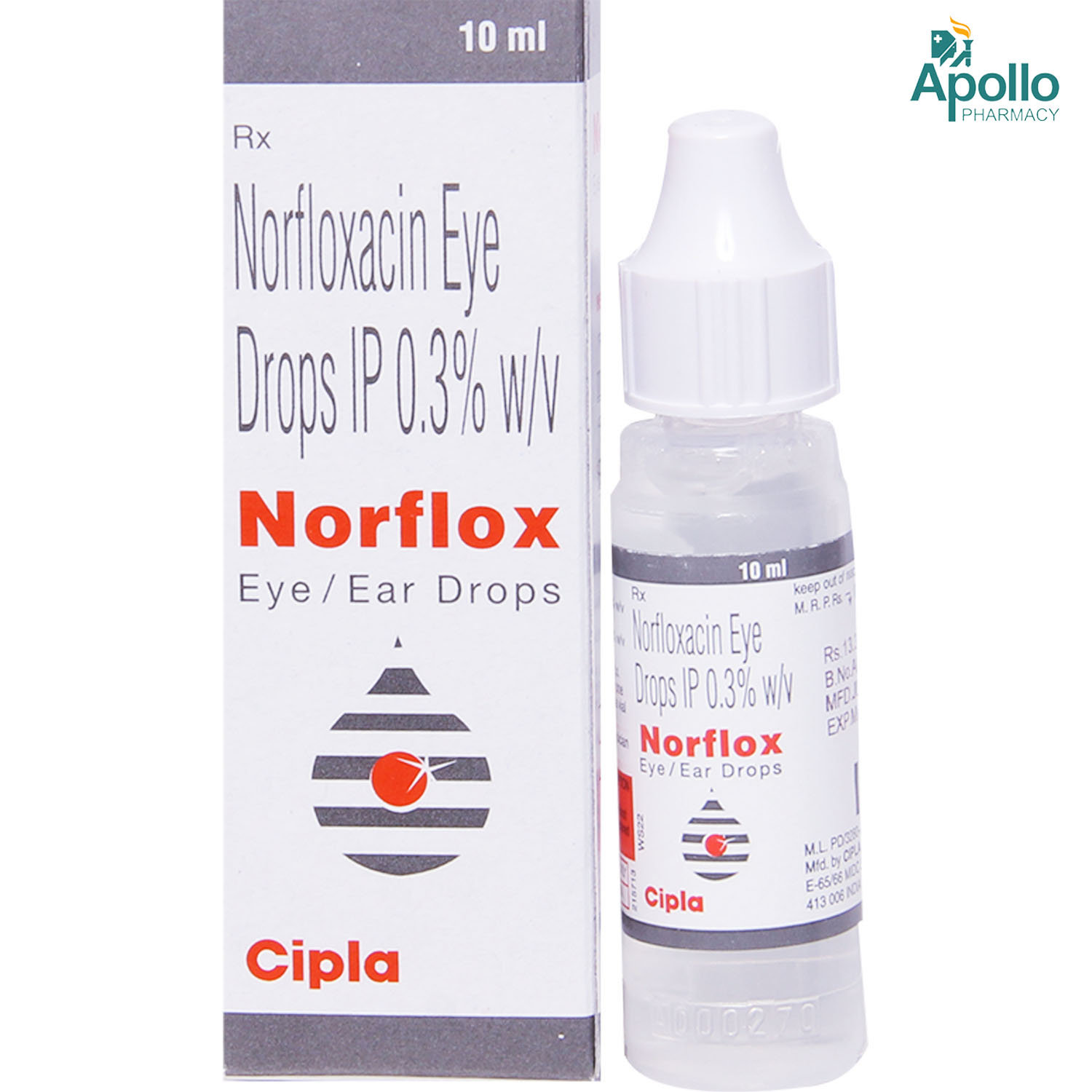Nordip Eye/Ear Drops


MRP ₹12.6
(Inclusive of all Taxes)
₹1.9 Cashback (15%)
Provide Delivery Location
Online payment accepted
 Prescription drug
Prescription drugWhats That
Composition :
Manufacturer/Marketer :
Consume Type :
Return Policy :
About Nordip Eye/Ear Drops
Nordip Eye/Ear Drops belongs to a group of medicines called antibiotics used to treat bacterial eye and ear infections. An ear infection occurs when the bacteria affect the middle or outer ear, leading to pain and inflammation. Bacterial eye infection occurs when harmful bacteria invade any part of the eye, such as the eyeball, conjunctiva, or cornea.
Nordip Eye/Ear Drops contains Norfloxacin, which works by inhibiting DNA-gyrase, an essential enzyme involved in DNA replication. Thus, it kills bacteria and treats bacterial eye/ear infections.
In some cases, Nordip Eye/Ear Drops may cause side effects, such as discomfort and local burning sensation. Most of these side effects do not require medical attention and will resolve gradually over time. However, you are advised to talk to your doctor if you experience these side effects persistently.
Consult your doctor before using Nordip Eye/Ear Drops if you are pregnant or breastfeeding. Nordip Eye/Ear Drops should be used in children only if prescribed by the doctor. Do not touch the tip of the dropper as it may contaminate the contents. Keep your doctor informed regarding your health condition and ongoing medications to prevent any side effects/interactions.
Uses of Nordip Eye/Ear Drops
Directions for Use
Medicinal Benefits
Nordip Eye/Ear Drops belongs to a group of medicines called fluoroquinolone antibiotics used to treat bacterial eye and ear infections. Nordip Eye/Ear Drops contains Norfloxacin, a broad-spectrum antibiotic that works by inhibiting DNA-gyrase, an essential enzyme involved in DNA replication. Thus, it kills bacteria and treats bacterial eye/ear infections.
Storage
Drug Warnings
Do not use Nordip Eye/Ear Drops if you are allergic to any of its components or if you have viral or fungal eye/ear infections. Inform your doctor if you have glaucoma, high blood pressure, ocular hypertension, diabetes, eye/ear infection or injury, or heart, kidney or liver problems. Consult your doctor before using Nordip Eye/Ear Drops if you are pregnant or breastfeeding. Nordip Eye/Ear Drops should be used in children only if prescribed by the doctor.
Diet & Lifestyle Advise
Eye infections:
- Wash your hands regularly. Avoid touching the eyes with dirty hands.
- Avoid rubbing the eyes.
- Avoid sharing eye makeup such as eyeliner, mascara or kohl.
- Always use clean towels or tissues to wipe your eyes and face.
- Regularly wash and change the pillowcases.
- If you wear contact lenses: Clean and replace contact lenses more often. Never share contact lenses. Always remember to wash your hands before inserting and after removing the contact lens.
Ear infections:
- Include fruits, vegetables, high-quality proteins and whole wheat grains in your diet to strengthen the immune system.
- Avoid consuming foods that you are allergic to as it can cause the body to produce excess mucus leading to inflammation.
- Avoid getting things like shampoo, soap, and water into the ear, as it can cause itching.
- Do not poke or scratch the ear, as it can cause damage to the ear canal, leading to inflammation.
- Avoid second-hand smoke.
- Stay healthy as immunity prevents infections.
Side Effects of Nordip Eye/Ear Drops
- Discomfort
- Burning sensation
Habit Forming
Therapeutic Class
Nordip Eye/Ear Drops Substitute

Product Substitutes
Author Details
We provide you with authentic, trustworthy and relevant information
FAQs
Nordip Eye/Ear Drops works by inhibiting DNA-gyrase, an essential enzyme involved in DNA replication. Thus, it kills bacteria and treats bacterial eye/ear infections.
To treat your condition effectually, continue using Nordip Eye/Ear Drops for as long as your doctor has prescribed it to you. Consult the doctor if the irritation persists or worsens.
Nordip Eye/Ear Drops can be used with other eye/ear medications if prescribed by your doctor. However, you are advised to maintain a gap of 10-15minutes between using Nordip Eye/Ear Drops and other eye/ear medications.
Do not use Nordip Eye/Ear Drops for longer durations unless prescribed, as it may lead to other infections. Consult your doctor if your condition worsens or does not improve despite using Nordip Eye/Ear Drops for a week.
Nordip Eye/Ear Drops may cause a local burning sensation. It is not necessary for everyone using Nordip Eye/Ear Drops to experience this side effect. However, if the condition persists or worsens, consult your doctor.
Disease/Condition Glossary
Bacterial eye infections: Bacterial eye infection occurs when harmful bacteria invade any part of the eye, such as the eyeball, conjunctiva, or cornea. Symptoms of an infection include red eye, pain, discharge, watery/dry eyes, swelling, itching, and sensitivity to light. The common bacterial eye infections are conjunctivitis, stye, and keratitis. Conjunctivitis (pink eye) is the infection/inflammation of the conjunctiva (white part of the eye) and the inner eyelid. A stye is a bump on the eyelid or base of eyelashes. Keratitis is the inflammation of the cornea. It is a common problem in people who wear contact lenses.
Bacterial ear infections: An ear infection occurs when the bacteria affect the middle or outer ear, leading to pain and inflammation. An ear infection occurs when the Eustachian tubes (small tubes that run from each ear to the back of the throat) become blocked or swollen. Infection of the middle ear (air-filled space behind the eardrum) is known as otitis media, whereas the inflammation of the external/outer ear canal that runs from the eardrum to the outside of the head is known as otitis externa. Ear infections can be painful due to inflammation and fluid build-up. Symptoms include pain or discomfort inside the ear, pus or fluid-like drainage from the ear, feeling of pressure inside the ear, and loss of hearing.

Have a query?
Alcohol
Caution
It is not known whether Nordip Eye/Ear Drops interacts with alcohol. Please consult your doctor if you have any concerns.
Pregnancy
Caution
If you are pregnant, please consult your doctor before using Nordip Eye/Ear Drops; your doctor will prescribe only if the benefits outweigh the risks.
Breast Feeding
Caution
If you are breastfeeding, please consult your doctor before using Nordip Eye/Ear Drops; your doctor will decide whether Nordip Eye/Ear Drops can be used by breastfeeding mothers or not.
Driving
Caution
The effects of Nordip Eye/Ear Drops on the ability to drive or operate machinery are unknown. Drive or operate machinery only if you are alert.
Liver
Caution
Please consult your doctor if you have any concerns regarding the usage of Nordip Eye/Ear Drops in patients with liver impairment.
Kidney
Caution
Please consult your doctor if you have any concerns regarding the usage of Nordip Eye/Ear Drops in patients with kidney impairment.
Children
Caution
Nordip Eye/Ear Drops should be used in children only if prescribed by the doctor.




_0.jpg?tr=q-85)

